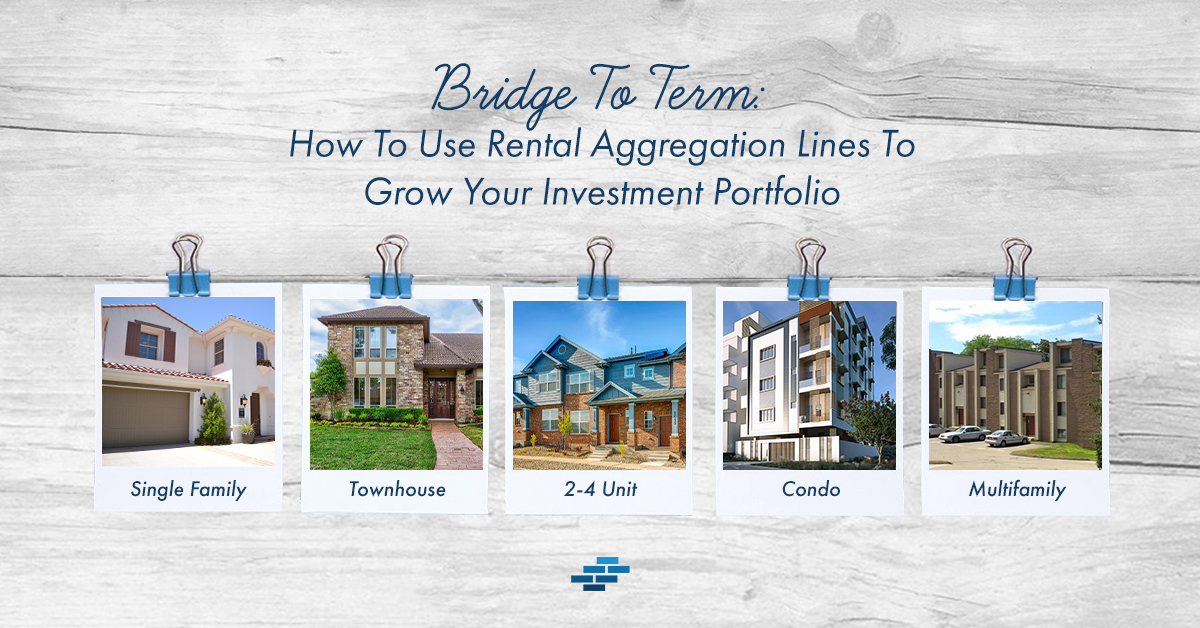Bridge to Term: How to Use Rental Aggregation Lines to Grow Your Investment Portfolio

Building a rental portfolio requires the right tools. And, while there are multiple methods to real estate investing, some ways are simply more effective and efficient than others. In order to maximize production and build a portfolio, all aspects of the asset cycle must be properly analyzed and targeted for effectiveness, efficiency, and cost.
Cycle of a Rental Property
The beginning stage of any rental asset from an investor’s simplified outlook is the point of acquisition. Whether it is a newly built asset, turnkey asset, or a moderate to extreme value-add asset, the first real step for an investor is the actual purchase of the property itself. This includes extensive research to identify the property and make a reasonable offer to the seller. The seller will likely be deciding between a multitude of offers, and will likely decide based on a combination of offer price, likelihood of closing, and speed of closing. This initial point is where seasoned investors often separate themselves from others by making the right offer and emphasizing their quick access to capital.
Upon the successful acquisition of the asset, the next phase consists of the value-add stage. Rehab work will be done to attract potential renters, and the property will eventually be leased out to a tenant.
An additional step an investor can take after rehab is to refinance the asset to recuperate the equity that has been invested.
Pitfalls of Conventional Methodology
Financing an acquisition is a great option, and there are many lenders and banks that can help facilitate this. However, investors in today’s market are often competing with all-cash offers from other potential buyers. Compared to years prior, there are simply fewer bargains on the market and more buyers than ever before. This makes it extremely tough as bank underwriting and funding on an asset typically takes much longer than an all-cash offer and provides an additional level of risk to the seller as there are loan contingencies attached to the offer.
To mitigate these concerns, investors typically turn to hard money lenders who promise immediate funding. But the primary issue with hard money lenders is the high cost of the overall loan. Typically, hard money lenders will charge upwards of 12% to 18% interest on a loan, depending on many factors including the duration of the loan. This high interest quickly eats into investors’ returns – especially if they do not pay the loan off quickly. Even still, many smaller hard money lenders only have a certain amount of capital to lend at any given time – meaning they might not have capital available when investors need to fund on a particular property.
The other option is to simply purchase with all cash to win the property. So long as you have the wherewithal to do so, this may seem like the safe option. However, what this really does is it “puts all your eggs into one basket”, as opposed to spreading your inherent risk across other assets if you were to acquire financing for multiple properties. In addition to the risk portion, it also limits your ability to grow your portfolio quickly.
For each of the above scenarios, the remaining stages of the asset cycle (value-add and refinance stages) have not yet been addressed. Once the acquisition is complete, investors will then need to rehab the asset through yet additional financing or inject more of their own money.
Lastly, if investors would like to refinance their now cash-flowing asset to recuperate the equity that was put in, their options may be limited and their rates may not be favorable. While Fannie Mae’s program allows investors to close on a maximum of 10 properties under their personal name, there are extremely limited options for any additional property after that – with rates starting at around the 7% range on individual asset refinances.
How CoreVest Solves the Problem
Savvy investors take advantage of all stages of the asset cycle, and CoreVest has created a program tailormade for investors to transition from acquisition to refinance. Our Rental Aggregation Credit Line is built specifically for investors looking to purchase multiple assets, rehab the properties, and refinance in-house via CoreVest’s Rental Portfolio Loan for more favorable long-term rates.
From the onset, we can pre-approve investors from anywhere between $1M – $50M based on financials (liquidity and net worth), credit score and investment experience. We then give the investors a “proof of funds” letter for which they can utilize in the marketplace to compete with cash offers, and we can fund with much more speed and certainty as the investor has already been pre-approved.
We typically fund between 80% – 90% of the purchase price on residential properties (single family, multifamily, townhomes, condos), and can finance up to 100% of the rehab. Rates start as low as 7.99% with the Rental Aggregation Credit Line and can be easily converted into our Rental Portfolio Loan with rates as low as 5.5% fixed.
The Credit Line is flexible, and many of our investors use it for both fix and flip as well as buying to hold. An added benefit for investors is that CoreVest can get even more aggressive on pricing when we know we will be refinancing the asset long-term, as well as providing a seamless and speedy transition that minimizes costs and makes the transaction much easier overall.
CoreVest is a leading provider of financing solutions to residential real estate investors. We provide attractive long-term debt products for stabilized rental portfolios as well as credit lines for new acquisitions.
For more information about how CoreVest can help grow your rental and rehab business, please call 844.223.2231 or submit our contact form.
#IG